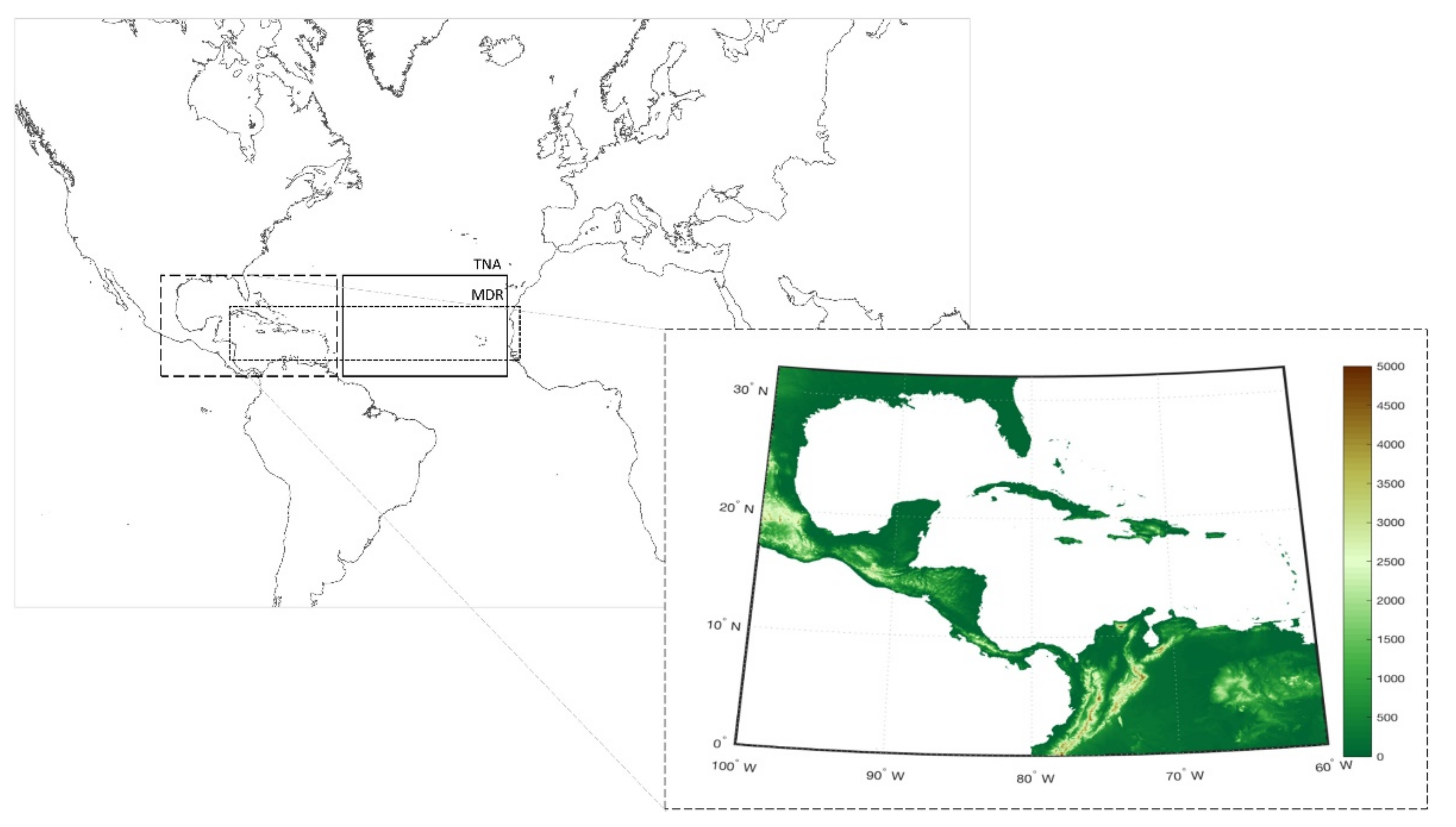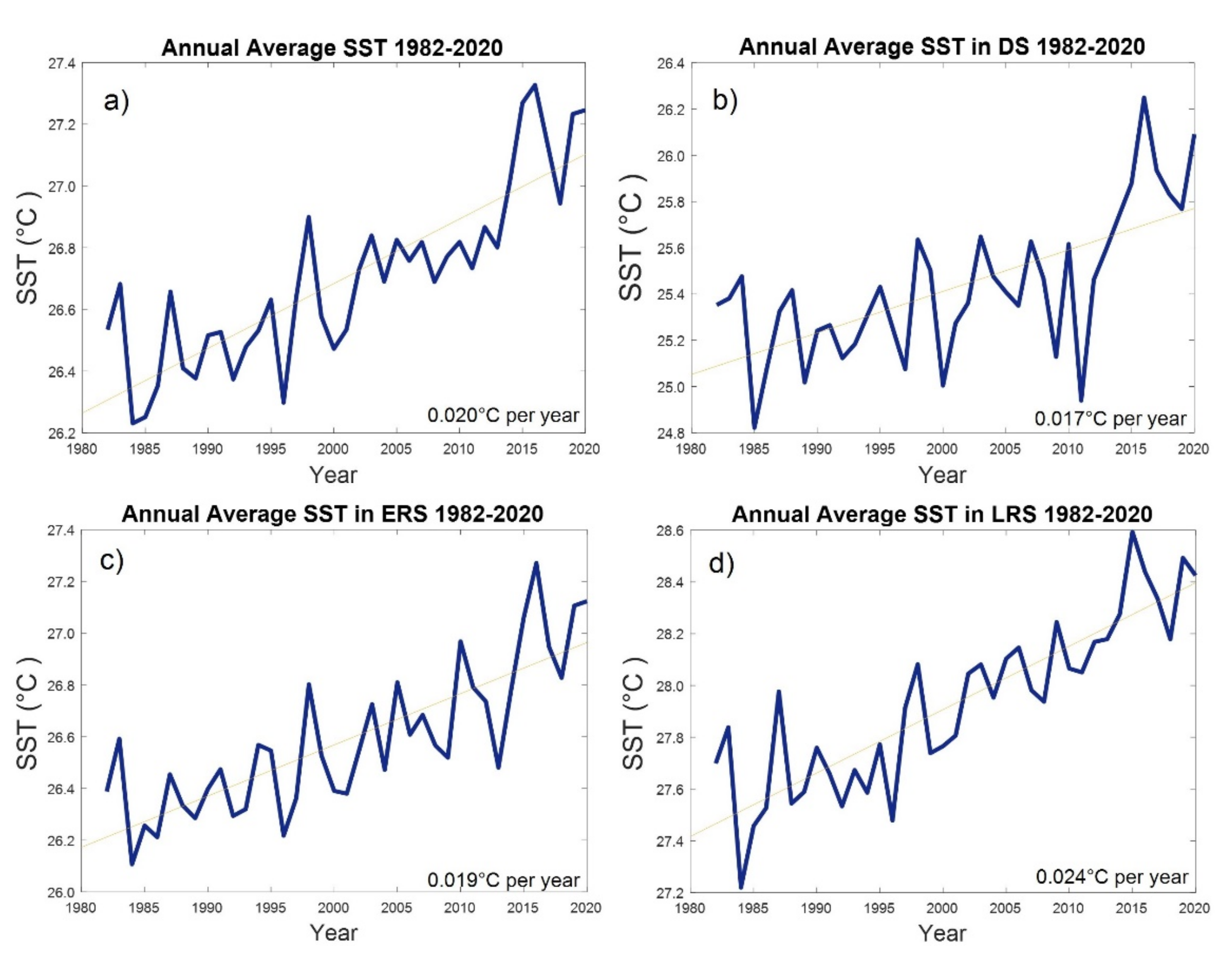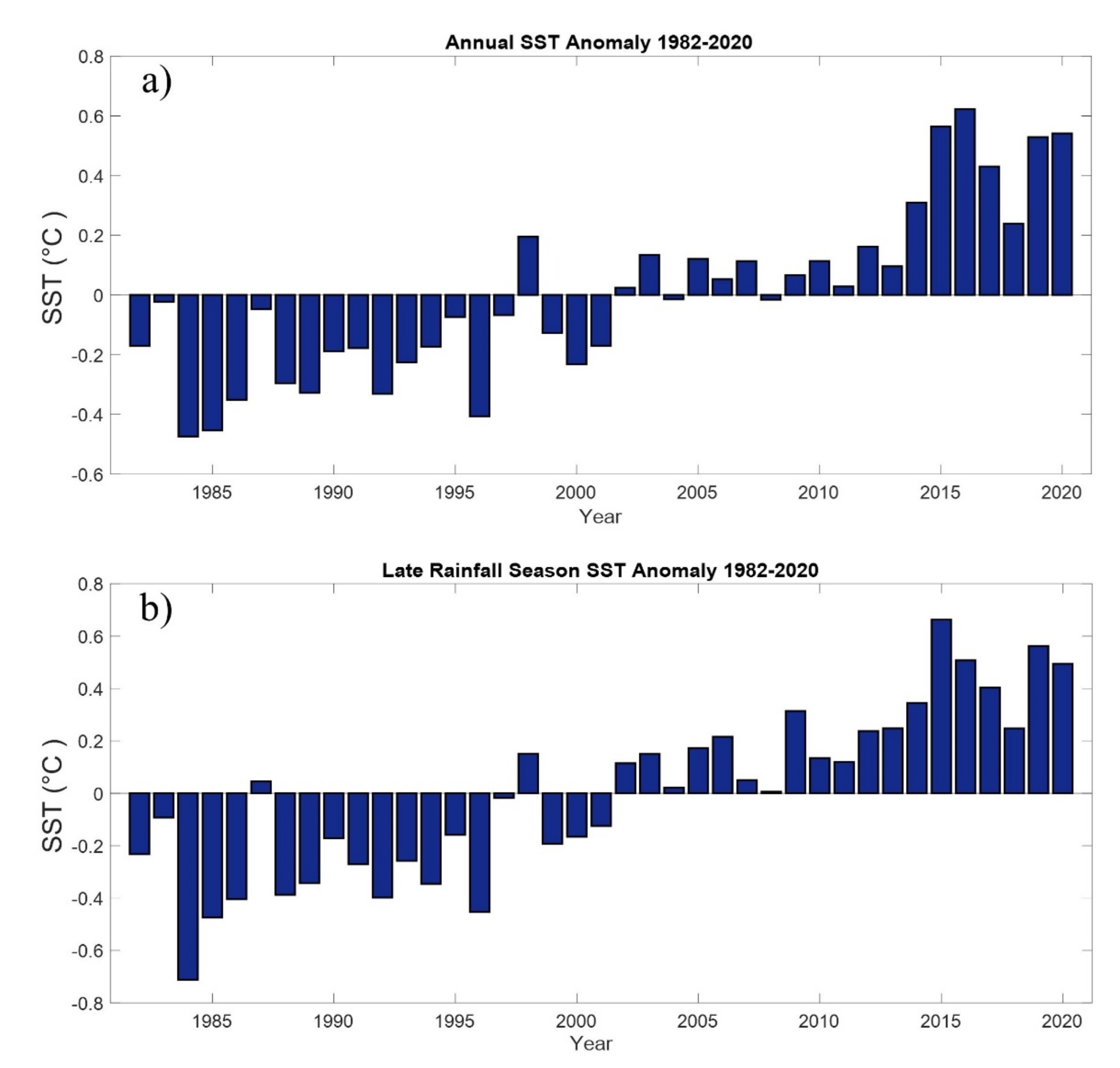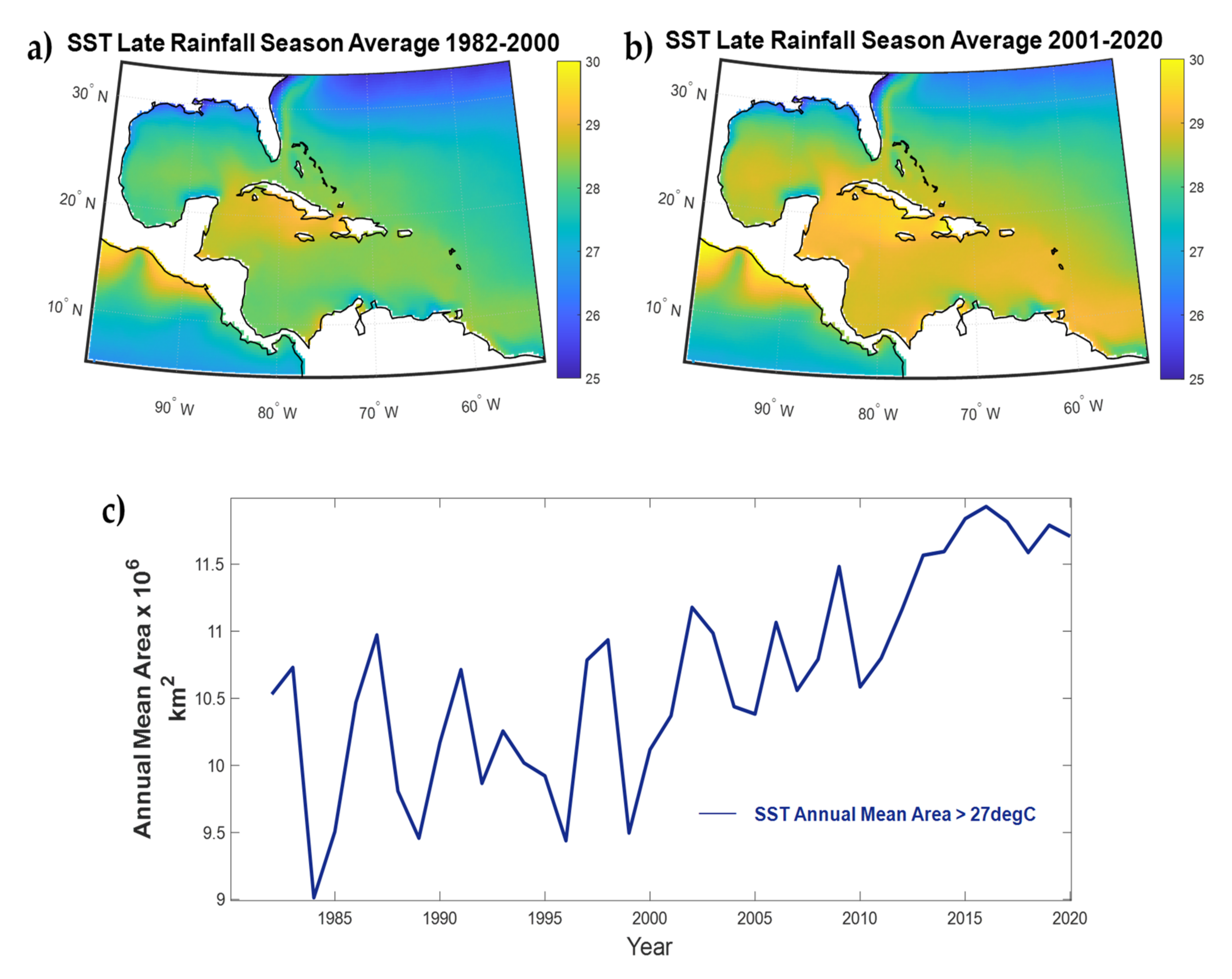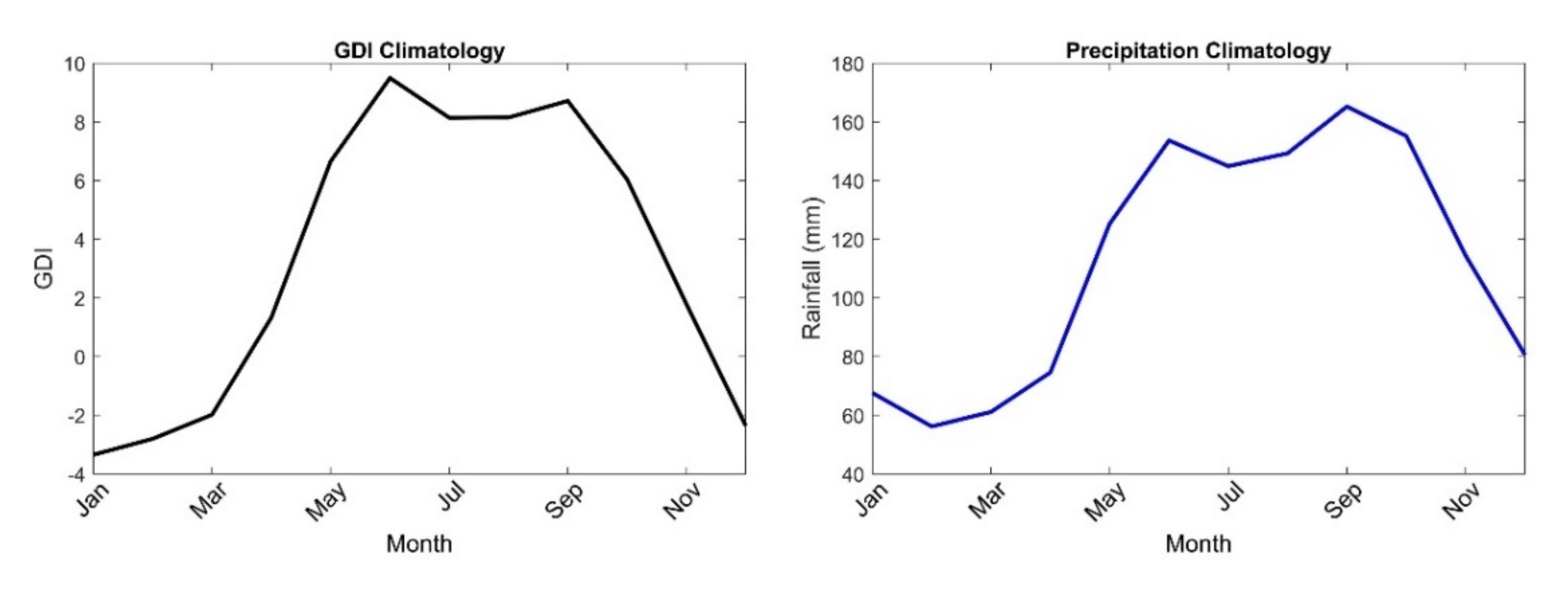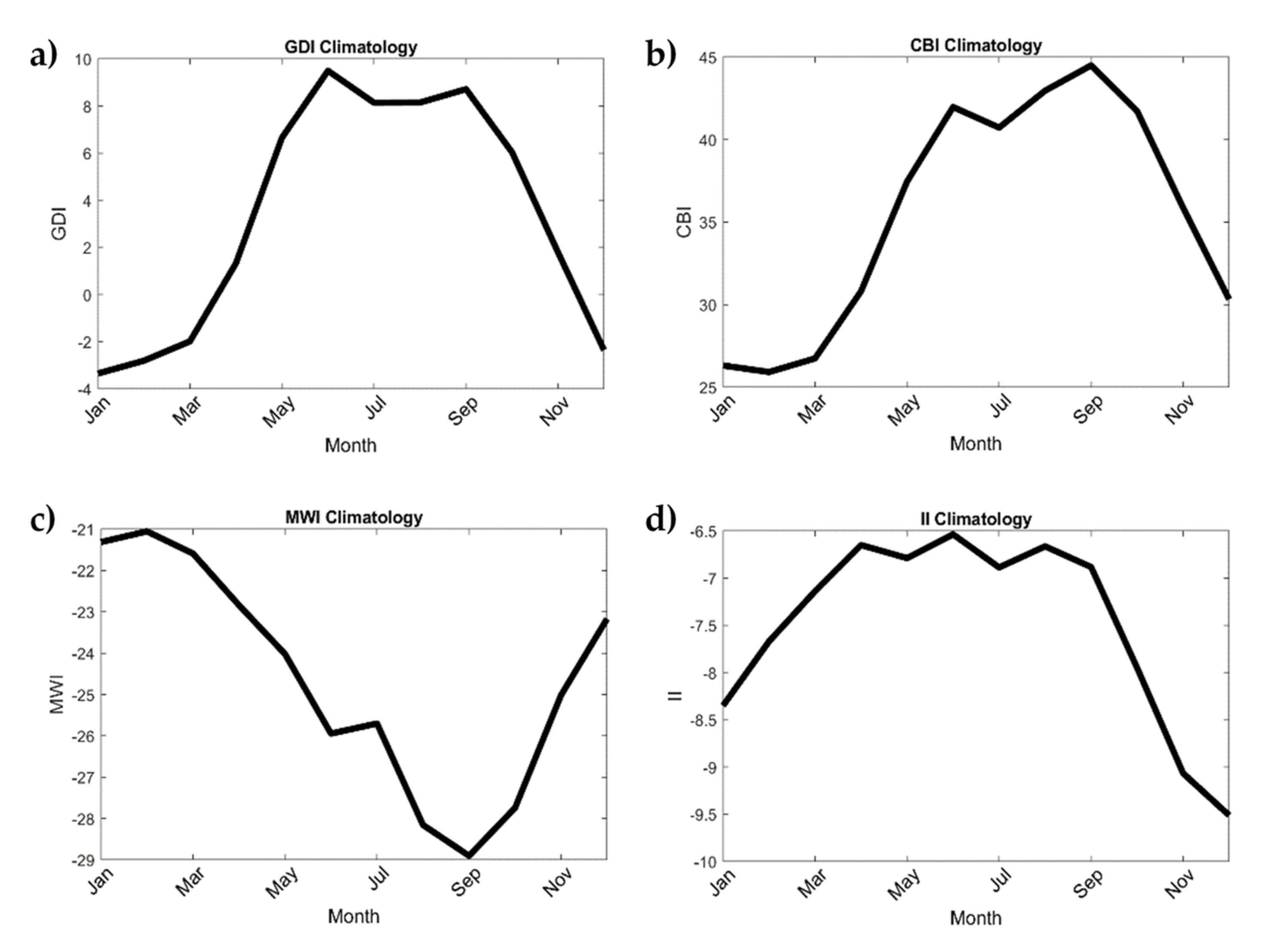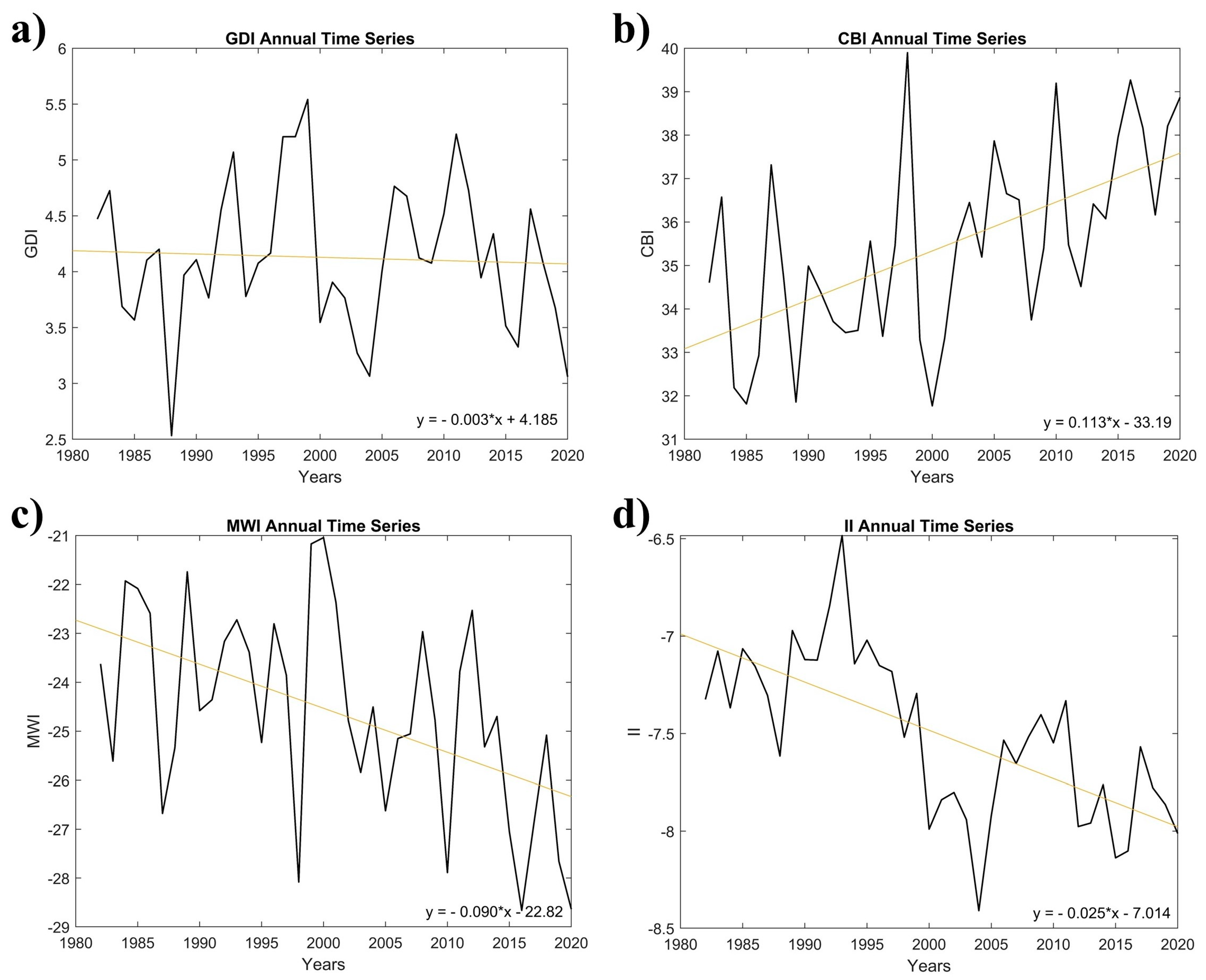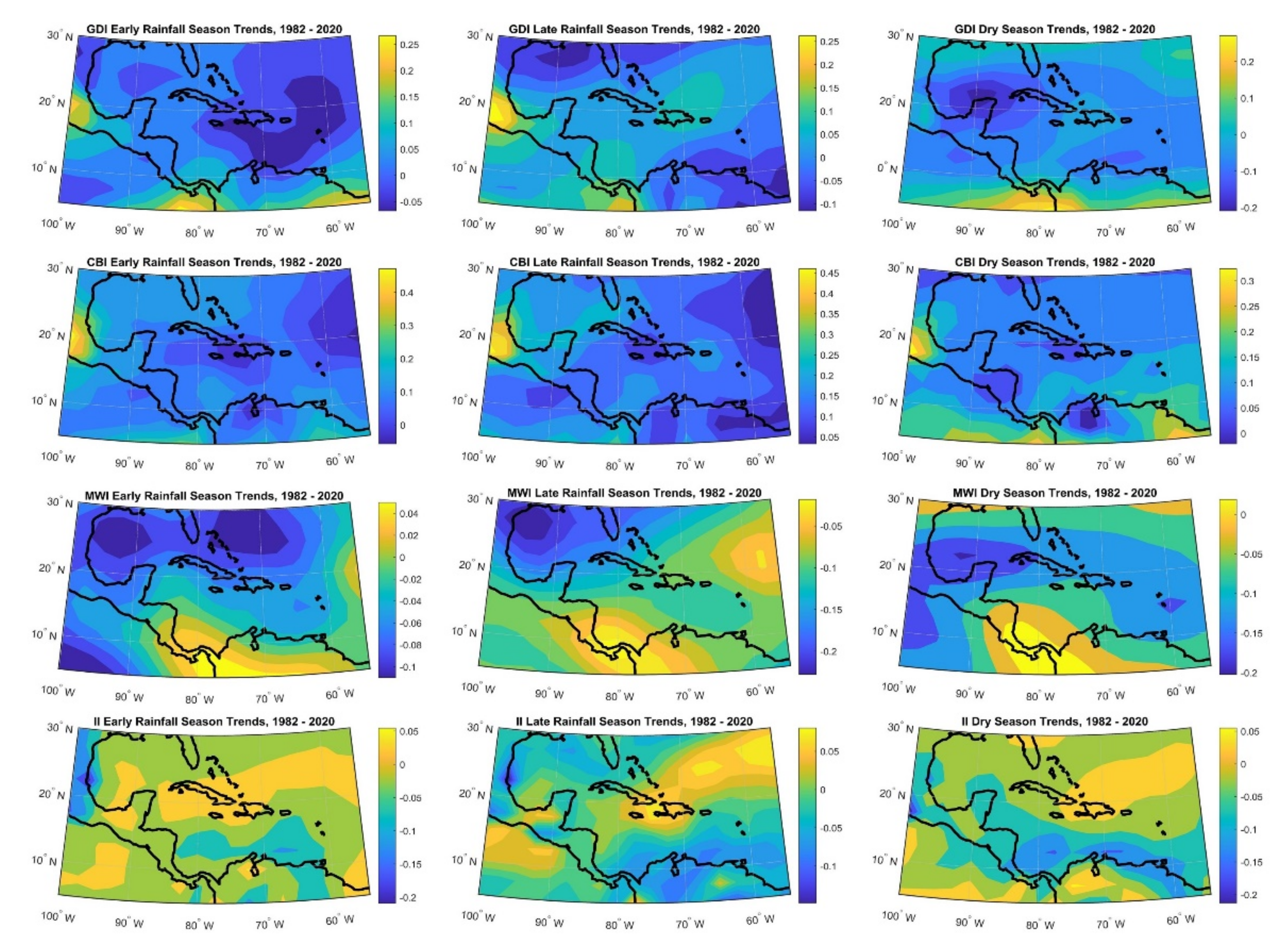Author Contributions
Conceptualization, E.G. and J.E.G.; Data curation, E.G.; Formal analysis, E.G.; Funding acquisition, J.E.G.; Investigation, E.G. and K.H.; Methodology, E.G., T.M.S., J.M.G., M.D. and J.E.G.; Resources, J.E.G.; Supervision, T.M.S. and J.E.G.; Validation, J.M.G. and M.D.; Visualization, E.G. and K.H.; Writing—original draft, E.G., T.M.S. and K.H.; Writing—review and editing, E.G., T.M.S., J.M.G., M.D., K.H. and J.E.G. All authors have read and agreed to the published version of the manuscript.
Figure 1.
Map depicting the extent of the Caribbean and surrounding region domain of interest (5°–31° N, 100° W–55° W) with color contours depicting the elevations (in meters), the Main Developing Region (10° N–20° N, 20° W–80° W), and the Tropical North Atlantic (0° N–40° N, 10° W–100° W).
Figure 1.
Map depicting the extent of the Caribbean and surrounding region domain of interest (5°–31° N, 100° W–55° W) with color contours depicting the elevations (in meters), the Main Developing Region (10° N–20° N, 20° W–80° W), and the Tropical North Atlantic (0° N–40° N, 10° W–100° W).
Figure 2.
Summary of regional (spatial) averaged trends from 1982–2020: (a) annual regional average SST time series for the Caribbean and surrounding region, (b) regional average of SST in the Dry Rainfall Season, (c) regional average of SST in the Early Rainfall Season, and (d) regional average of SST in the Late Rainfall Season.
Figure 2.
Summary of regional (spatial) averaged trends from 1982–2020: (a) annual regional average SST time series for the Caribbean and surrounding region, (b) regional average of SST in the Dry Rainfall Season, (c) regional average of SST in the Early Rainfall Season, and (d) regional average of SST in the Late Rainfall Season.
Figure 3.
Caribbean and surrounding region sea surface temperature anomalies observation: (a) annual SST anomaly 1982–2020 and (b) Late Rainfall Season SST anomaly 1982–2020.
Figure 3.
Caribbean and surrounding region sea surface temperature anomalies observation: (a) annual SST anomaly 1982–2020 and (b) Late Rainfall Season SST anomaly 1982–2020.
Figure 4.
Late Rainfall Season sea surface temperature averages for warming SST observation: (a) 1982–2000, (b) 2001–2020, and (c) convection threshold Area Index time series for the Caribbean and surrounding region. The color bar indicates the temperature (°C).
Figure 4.
Late Rainfall Season sea surface temperature averages for warming SST observation: (a) 1982–2000, (b) 2001–2020, and (c) convection threshold Area Index time series for the Caribbean and surrounding region. The color bar indicates the temperature (°C).
Figure 5.
The Galvez-Davidson Index (GDI) annual climatology (left) and the precipitation annual climatology (right) for the Caribbean and surrounding region (5°–31° N, 100° W–55° W), also referred to as the Intra-Americas Region (IAR), for base period 1982–2020.
Figure 5.
The Galvez-Davidson Index (GDI) annual climatology (left) and the precipitation annual climatology (right) for the Caribbean and surrounding region (5°–31° N, 100° W–55° W), also referred to as the Intra-Americas Region (IAR), for base period 1982–2020.
Figure 6.
Galvez-Davidson Index (GDI) and sub-index annual climatology results for the (a) the GDI, (b) Column Buoyancy Index (CBI), (c) the Mid-level Warming Index (MWI), and (d) the Inversion Index (II) for the Caribbean and surrounding region (5°–31° N, 100° W–55° W) for base period 1982–2020.
Figure 6.
Galvez-Davidson Index (GDI) and sub-index annual climatology results for the (a) the GDI, (b) Column Buoyancy Index (CBI), (c) the Mid-level Warming Index (MWI), and (d) the Inversion Index (II) for the Caribbean and surrounding region (5°–31° N, 100° W–55° W) for base period 1982–2020.
Figure 7.
Summary of annual regional (spatial) averaged trends over 1982–2020 for (a) the Galvez-Davidson Index (GDI), (b) Column Buoyancy Index (CBI), (c) the Mid-level Warming Index (MWI), and (d) the Inversion Index (II).
Figure 7.
Summary of annual regional (spatial) averaged trends over 1982–2020 for (a) the Galvez-Davidson Index (GDI), (b) Column Buoyancy Index (CBI), (c) the Mid-level Warming Index (MWI), and (d) the Inversion Index (II).
Figure 8.
Regional trends (slope) per grid for the Galvez-Davidson Index (GDI) and individual sub-indices for the Column Buoyancy Index (CBI), the Mid-level Warming Index (MWI), and the Inversion Index (II).
Figure 8.
Regional trends (slope) per grid for the Galvez-Davidson Index (GDI) and individual sub-indices for the Column Buoyancy Index (CBI), the Mid-level Warming Index (MWI), and the Inversion Index (II).
Table 1.
List of acronyms.
Table 1.
List of acronyms.
| List of Acronyms |
|---|
| AWP | Atlantic Warm Pool | LRS | Late Rainfall Season |
| CAPE | Convective Available Potential Energy | MK | Mann-Kendall |
| CBI | Column Buoyancy Index | MSD | Mid-Summer Drought |
| CLLJ | Caribbean Low-Level Jet | MWI | Mid-Level Warming Index |
| DS | Dry Season | NAO | North Atlantic Oscillation |
| ENSO | El Niño Southern Oscillation | NCAR | National Center for Atmospheric Research |
| ERS | Early Rainfall Season | NCEP | National Centers for Environmental Prediction |
| GDI | Gálvez-Davison Index | NOAA | National Oceanic and Atmospheric Administration |
| GPCP | Global Precipitation Climatology Project | OI | Optimum Interpolated |
| IAR | Intra-Americas Region | SST | Sea Surface Temperature |
| II | Inversion Index | TC | Terrain Correction |
| IPCC | Intergovernmental Panel on Climate Change | TNA | Tropical North Atlantic |
Table 2.
Summary of Galvez–Davidson Index (GDI) and expected types of convective regimes based on the Caribbean and surrounding region.
Table 2.
Summary of Galvez–Davidson Index (GDI) and expected types of convective regimes based on the Caribbean and surrounding region.
| GDI Value | Expected Convective Regime |
|---|
| GDI > +45 | Scattered to widespread heavy rain producing thunderstorms |
| +35 to +45 | Scattered thunderstorms, some capable of producing heavy rainfall |
| +25 to +35 | Isolated to scattered thunderstorms and/or scattered shallow convection |
| +15 to +25 | Isolated thunderstorms, but mostly shallow convection |
| +05 to +15 | Isolated, brief thunderstorm possible—potential for shallow convection |
| −20 to +05 | Strong subsidence inversion likely—isolated to scattered shallow convection |
| −20 > GDI | Strong subsidence inversion. Convection should be shallow, isolated and produce trace accumulations |
Table 3.
List of p-values for regional (spatial) averaged SST trends.
Table 3.
List of p-values for regional (spatial) averaged SST trends.
| p-value | Annual | DS | ERS | LRS |
| 2.15 × 10−11 | 7.29 × 10−6 | 9.05 × 10−10 | 1.39 × 10−12 |
Table 4.
List of p-values for regional (spatial) averaged GDI trends.
Table 4.
List of p-values for regional (spatial) averaged GDI trends.
| p-value | GDI | CBI | MWI | II |
| 0.7341 | 2.14 × 10−4 | 0.004 | 1.19 × 10−5 |
Table 5.
List of p-values for regional (spatial) averaged trends per season for the GDI and subindices.
Table 5.
List of p-values for regional (spatial) averaged trends per season for the GDI and subindices.
| | GDI | CBI | MWI | II |
|---|
| ERS | 0.2555 | 0.005 | 0.0076 | 0.0018 |
| LRS | 0.1997 | 2.60 × 10−11 | 1.85 × 10−5 | 0.0029 |
| DS | 0.0331 | 0.019 | 3.33 × 10−9 | 0.0000 |
Table 6.
Summary of regional precipitation correlations with SST and GDI (bold represents significance at 95% test level).
Table 6.
Summary of regional precipitation correlations with SST and GDI (bold represents significance at 95% test level).
| Precipitation | Regional Average Correlation |
|---|
| | SST | GDI |
| Annual | 0.2557 | 0.3779 |
| ERS | 0.2669 | 0.604 |
| LRS | −0.0868 | 0.3677 |
| DS | 0.4432 | 0.5615 |
Table 7.
Summary of regional sea-surface temperatures (SST) correlations with GDI (bold represents statistical significance at 95% test level).
Table 7.
Summary of regional sea-surface temperatures (SST) correlations with GDI (bold represents statistical significance at 95% test level).
| SST | GDI | CBI | MWI | II |
|---|
| Annual | −0.06 | 0.84 | −0.78 | −0.64 |
| ERS | 0.15 | 0.77 | −0.69 | −0.5 |
| LRS | 0.13 | 0.86 | −0.83 | −0.47 |
| DS | −0.17 | 0.83 | −0.77 | −0.39 |
